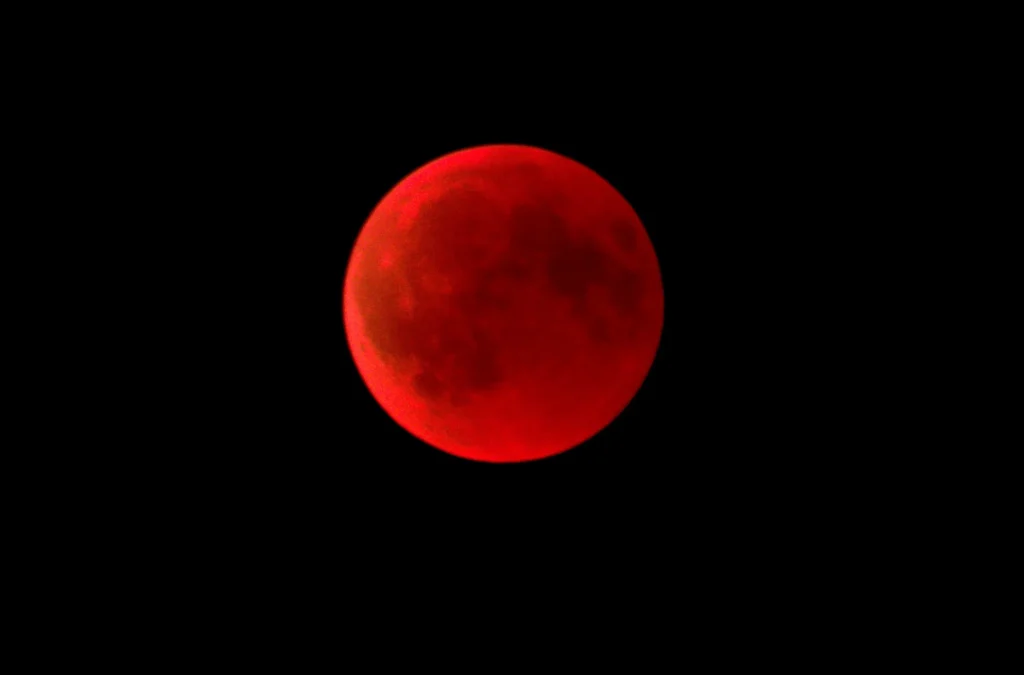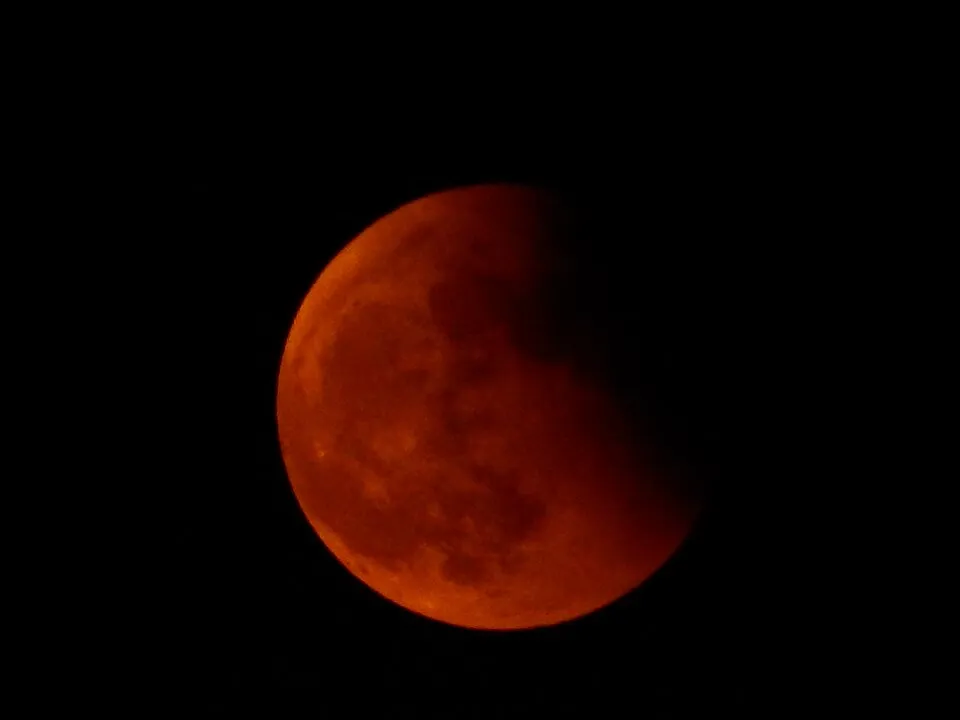KEY HIGHLIGHTS:
- Total lunar eclipse visible across all Indian states on September 7-8, 2025, marking the first nationwide visibility since July 2018
- Blood moon phenomenon creates dramatic red coloration lasting 82 minutes during totality phase from 11:00 PM to 12:22 AM IST
- Next opportunity to witness similar celestial event in India not until December 31, 2028
Opening Overview
A spectacular total lunar eclipse, commonly known as a blood moon, captivated skywatchers across India on September 7-8, 2025, creating one of the most remarkable celestial displays in recent years. This rare astronomical event marked the first time since July 27, 2018 that a total lunar eclipse was visible from every corner of the Indian subcontinent. The blood moon phenomenon transformed the lunar surface into a brilliant copper-red orb, offering astronomy enthusiasts and casual observers alike an unforgettable viewing experience spanning nearly five and a half hours.

The total lunar eclipse began with the penumbral phase at 8:58 PM IST on September 7, reaching its dramatic peak during the blood moon totality phase at 11:42 PM IST. According to the India Meteorological Department, this total lunar eclipse provided optimal viewing conditions across all Indian states and union territories, with the entire sequence concluding at 2:25 AM IST on September 8. The extended duration of 82 minutes for the totality phase made this blood moon one of the longest lunar eclipses witnessed since 2022.
Eclipse Timing and Visibility Across India
The total lunar eclipse unfolded in distinct phases, each offering unique observational opportunities for astronomy enthusiasts throughout India. The event commenced with the penumbral eclipse phase at 8:58 PM IST, when Earth’s outer shadow began its subtle influence on the lunar surface. The partial eclipse phase initiated at 9:57 PM IST, marking the beginning of Earth’s umbra covering portions of the Moon’s visible surface.
The most anticipated segment, the blood moon totality phase, began precisely at 11:00 PM IST and continued until 12:22 AM IST on September 8, creating an 82-minute window of spectacular red illumination. The maximum eclipse occurred at approximately 11:42 PM IST, when the Moon appeared at its deepest red coloration. The total lunar eclipse gradually concluded with the partial phase ending at 1:26 AM IST, followed by the final penumbral phase concluding at 2:25 AM IST.

Timings of Total Lunar Eclipse Phases on September 7-8, 2025 in India
Major metropolitan areas including Mumbai, Delhi, Bengaluru, Kolkata, and Ahmedabad experienced identical timing for the total lunar eclipse, with 100% obscuration rates ensuring optimal viewing conditions. Weather forecasts indicated varying cloud coverage percentages, with Delhi showing the most favorable conditions at 62% average cloud cover, while Kolkata faced higher cloud coverage at 93%.
Scientific Explanation of the Blood Moon Phenomenon
The striking red appearance during a total lunar eclipse results from a fascinating atmospheric phenomenon called Rayleigh scattering, the same scientific principle that creates red sunsets and blue skies. During the blood moon phase, Earth positions itself directly between the Sun and Moon, casting its umbral shadow across the lunar surface. Rather than complete darkness, the Moon receives filtered sunlight that has passed through Earth’s atmosphere.
Rayleigh scattering occurs when sunlight encounters particles in Earth’s atmosphere that are smaller than the light’s wavelengths. Blue and violet wavelengths, being shorter, scatter in multiple directions and are effectively removed from the light reaching the Moon during the total lunar eclipse. Red and orange wavelengths, with their longer frequencies, pass through Earth’s atmosphere more efficiently and bend around our planet to illuminate the Moon’s surface.

The intensity and exact shade of the blood moon coloration depends on atmospheric conditions, including dust particles, volcanic activity, and weather patterns in Earth’s atmosphere during the total lunar eclipse. NASA explains that air molecules scatter out most blue light, while the remaining red-tinted light reflects onto the Moon’s surface, creating the characteristic crimson glow that defines the blood moon experience.
Optimal Viewing Conditions and Photography Guidelines
The total lunar eclipse required no specialized equipment for observation, making it accessible to viewers across all skill levels and economic backgrounds. Unlike solar eclipses that demand protective filters, the blood moon could be safely viewed with the naked eye throughout its entire duration. However, astronomy experts recommended finding locations away from urban light pollution to maximize the visual impact of the total lunar eclipse.
Binoculars enhanced the viewing experience by revealing subtle surface details on the Moon during the blood moon phase, while telescopes provided even greater magnification for serious astronomical observation. Photography enthusiasts found optimal conditions during the totality phase, when the total lunar eclipse created dramatic red illumination perfect for long-exposure captures.
The extended 82-minute duration of the blood moon phase provided ample opportunities for documentation and observation from multiple locations. Astronomical societies across India organized public viewing events, enabling broader community participation in this rare total lunar eclipse. Weather conditions played a crucial role, with clear skies essential for optimal viewing of the blood moon phenomenon.
The Indian subcontinent’s geographical position offered particularly favorable viewing angles for the total lunar eclipse, with the Moon positioned high in the sky during peak hours. This elevation ensured minimal atmospheric interference and maximum clarity for observing the blood moon transformation.
Final Perspective
The September 7-8, 2025 total lunar eclipse represented a pivotal moment for astronomical observation in India, combining optimal visibility conditions with extended duration to create an exceptional blood moon experience. The 82-minute totality phase provided unprecedented opportunities for both scientific study and public engagement with celestial phenomena. This total lunar eclipse marked the culmination of perfect astronomical alignment, with Earth’s position creating ideal conditions for the blood moon effect across the entire Indian subcontinent.
The rarity of such comprehensive visibility makes this total lunar eclipse historically significant for Indian astronomy. The next comparable blood moon event visible from India will not occur until December 31, 2028, emphasizing the unique nature of the September 2025 eclipse. The successful observation of this total lunar eclipse across all Indian states demonstrated the country’s growing interest in astronomical events and the importance of public science education through accessible celestial phenomena like the blood moon.


